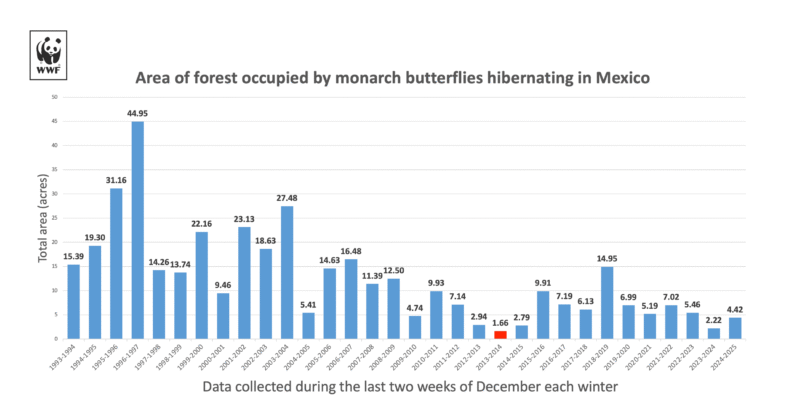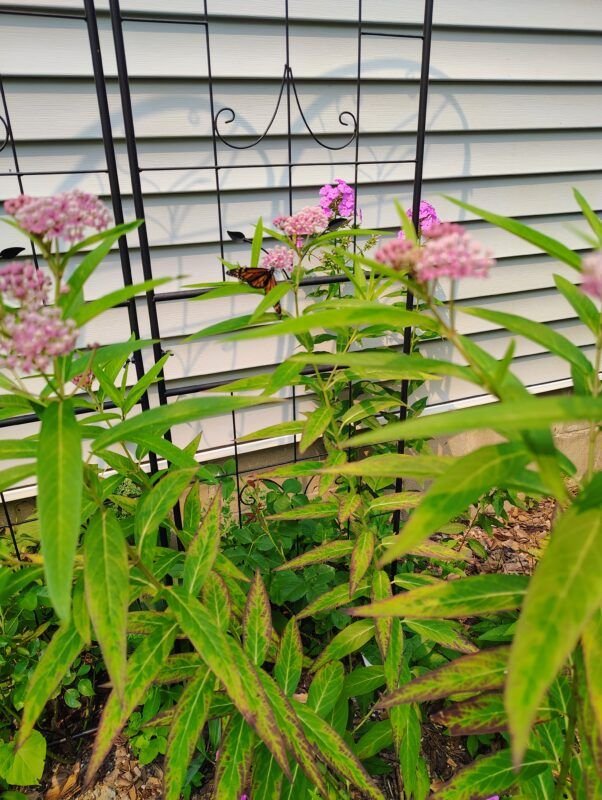The merit of milkweed
My video from the first week of August 2025
Suddenly there’s a surge in milkweed purchases. Why? Because nature lovers know that planting milkweed in your garden will help to increase the number of monarch butterflies in your area. The plants you choose for your garden (native plants to your region) make a huge difference in supporting wildlife and the environment.
As many of you know, monarch populations have been sadly decreasing due to housing development and agriculture, thus eliminating milkweed, the one plant that used to be abundant across America, leading to a huge decline of Danaus plexippus (their scientific name). In fact, monarch population numbers have been down by over 90% in recent years! However, there is good news. Numbers have climbed by nearly 50% in 2025 according to the National Wildlife Federation. Still, we have a long way to go.

So, last fall I ordered a milkweed plant (see my photo, below). Let’s give it a shot, we agreed. Little did we expect anything. Yet, lo and behold, three days ago I noticed a monarch caterpillar feeding on the plant. I couldn’t believe my eyes. One plant. Just one plant among all the flowers in our yard. Yet sure enough, a monarch found it and a new life begins in one front yard in a northern lower Michigan town.

The butterfly Lifecycle
The migratory cycle of the monarch butterfly is a remarkable natural phenomenon.
Each year, between 200 million and 600 million monarchs hibernate in the Oyamel fir forests of central Mexico. They stay in this cool environment, where temperatures hover just above 40°F, from late fall through winter — the ideal range for hibernation.
As temperatures rise above 55°F and days lengthen in February, the monarchs begin their migration northward. They travel approximately 800 miles, primarily crossing into Texas and surrounding states. Once there, the monarchs mate, lay eggs and die. The eggs are considered the first generation of the year. The eggs hatch within two to three weeks, and the resulting caterpillars will grow for another two to three weeks before forming chrysalises. After another 10 days, those caterpillars complete the metamorphosis into an adult butterfly and emerge from the chrysalis.
It takes three generations of monarch butterflies to journey north, but just one generation to return to Mexico, where the cycle begins anew.
Joe Lamp’l and Anurag Agrawal
The mysteries of milkweed
Monarch caterpillars can only eat one genus of plants to survive, Asclepias, commonly known as milkweed. There are about 200 species of milkweed, but their zoning ranges (growing area) vary. It’s quite an unbelievable story but milkweed is actually poisonous and the ONLY plant that where an adult will lay her eggs. And she aims to lay her egg on only one plant, thus avoiding plants where an egg has been laid already. As you can imagine, hundreds of millions of individual milkweed plants are necessary to sustain the current population of hundreds of million monarchs.
When a monarch caterpillar hatches, the first thing it eats is its own eggshell. Then the caterpillar eats milkweed, and nothing else, until it forms a chrysalis and becomes a butterfly.
Before a caterpillar can feed on a leaf of a milkweed plant, it must shave off spiky leaf hairs, called trichomes, one by one. The caterpillar doesn’t eat these hairs but clips each one off at the base and brushes it aside to clear an area where it can sink its mandibles into the leaf surface. But those trichomes are only the first line of the milkweed’s defense against insects that would like to eat it.
Milkweed is named for the toxic, milky and sticky sap or latex that oozes through its veins. The latex is pressurized within the plant, so once a caterpillar punctures the tissue, it’s met with a gush of gluey toxin powerful enough to knock the creature off the plant. Caterpillars that can hold on will continue to feed and focus their efforts on severing the veins of the plant that transport the latex. Once it breaks through the vein, a caterpillar can enjoy the leaf without encountering gushes of the toxic substance.
The caterpillars inevitably consume some of the toxic latex, and those toxins, called cardiac glycosides, are sequestered in the caterpillar’s body. As a result, monarch caterpillars and monarch butterflies are toxic to predators like birds.
Joe Lamp’l and Dr. Anurag Agrawal
Did you know?
That until recently here in Michigan, milkweed was banned as a noxious weed. Oh dear. Not good news for our winged friends. However, in March of 2024, House Bill 4857 was signed into law. Thank goodness they came to their senses.
Buying milkweed
The numerous varieties can be purchased as seed or potted plants. They can be found at local garden markets in your area or at any number of online sites. Recently I purchased additional plants at Garden for Wildlife – three Whorled Milkweed and three Orange Butterfly Milkweed plants that will be delivered early this fall.
Interested in learning more?
Try these books:
A highly rated book – Monarchs & Milkweed by Anurag Agrawal
The Monarch: Saving Our Most-Loved Butterfly by Kylee Baumle
How to Raise Monarch Butterflies: A Step-by-Step Guide for Kids (How It Works) by Carol Pasternak – a great book for children
Try these websites:
The Joe Gardener Show
NWF – Milkweed for Monarchs
Coastal Georgia Botanical Gardens
National Park Service
North American Butterfly Association
Try these videos:
